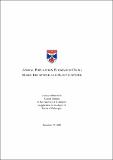Files in this item
Animal population estimation using mark-recapture and plant-capture
Item metadata
| dc.contributor.advisor | Goudie, Ian B.J. | |
| dc.contributor.advisor | Jupp, Peter E. | |
| dc.contributor.author | Gormley, Richard | |
| dc.coverage.spatial | xiii, 126 | en_US |
| dc.date.accessioned | 2013-06-10T14:10:47Z | |
| dc.date.available | 2013-06-10T14:10:47Z | |
| dc.date.issued | 2012 | |
| dc.identifier | uk.bl.ethos.574771 | |
| dc.identifier.uri | https://hdl.handle.net/10023/3655 | |
| dc.description.abstract | Mark-recapture is a method of population estimation that involves capturing a number of animals from a population of unknown size on several occasions, and marking those animals that are caught each time. By observing the number of marked animals that are subsequently seen, estimates of the total population size can be made. There are various subclasses of the mark-recapture method called the Otis-class of models (Otis, Burnham, White & Anderson 1978). These relate to the assumed behaviour of the individuals in the target population. More recent work has generalised the theory of mark-recapture to the so-called plant-capture, where a known number of animals are pre-inserted into the target population. Sampling is then carried out as normal, but with additional information coming from knowledge of the number of planted individuals. The theory underpinning plant-capture is less well-developed than mark-recapture, with the difference on population estimation of the former over the latter not often tested. This thesis shows that, under fixed and random sample-size models, the inclusion of plants can improve the mean point population estimation of various estimators. The estimator of Pathak (1964) is generalised to allow for the inclusion of plants into the target population. The results show that mean estimates from most estimators, under most models, can be improved with the inclusion of plants, and the sample standard deviations of the simulations can be reduced. This improvement in mean point population estimation is particularly pronounced when the number of animals captured is low. Sample coverage, which is the proportion of distinct animals caught during sampling, is also often sought by practitioners. Given here is a generalisation of the inverse population estimator of Pathak (1964) to plant-capture and a proposed new inverse population estimator, which can be used as estimates of the coverage of a sample. | en_US |
| dc.language.iso | en | en_US |
| dc.publisher | University of St Andrews | |
| dc.subject.lcc | QL752.G78 | |
| dc.subject.lcsh | Animal populations--Estimates--Mathematical models | en_US |
| dc.subject.lcsh | Population biology--Statistical methods | en_US |
| dc.title | Animal population estimation using mark-recapture and plant-capture | en_US |
| dc.type | Thesis | en_US |
| dc.contributor.sponsor | Engineering and Physical Sciences Research Council (EPSRC) | en_US |
| dc.type.qualificationlevel | Doctoral | en_US |
| dc.type.qualificationname | PhD Doctor of Philosophy | en_US |
| dc.publisher.institution | The University of St Andrews | en_US |
This item appears in the following Collection(s)
Items in the St Andrews Research Repository are protected by copyright, with all rights reserved, unless otherwise indicated.

